Bright stems for winter colour
Bright stems for winter colour are a great way to add impact in your garden. As the last of the leaves on deciduous plants change colour and fall, it would be easy to think that is the end of the colourful displays until spring. By selecting a few plants for your garden, you can continue to have splashes of colour right throughout the winter. Where space is limited, choosing the right plant is even more important.
There are some winter-flowering shrubs, but for an even better year-round display, choose plants that offer flower and foliage interest during the warmer months, but also come into their own in the winter with impactful, interesting and colourful stems. Here are some of my favourite plants for colourful and interesting stems during winter.
Cornus alba ‘Sibirica’

I planted a hedge of the dark red stemmed dogwood a couple of years ago and it is already providing shelter for wildlife and colour interest. During the spring and summer, it is produces small, flat heads of pretty insignificant white flowers, followed by white berries and then red tinged leaves in autumn. But it comes into its own in winter, when the red stems stand out against almost any background. The younger stems tend to be brightest, so prune hard in late March to early April as the new leaves are appearing.
Propagate from hardwood cuttings. While you could cut some stems for propagating during late autumn or early winter, I tend to wait until I prune in spring and use the material that I have pruned away for cuttings. I simply cut a slit into the ground and push stems in, around the existing plants, or you could use a designated trench or pots.
Betula utilis subsp. jacquemontii
A silver birch with white bark that stands out well during the darker months of the year. It is often sold as a multi-stemmed plant to provide maximum impact. Like most birches, this tree grows rapidly reaching 18-20m in 10-20 years depending on conditions. It requires little or no pruning, but if it does need to be pruned, do so in late summer to autumn. Avoid pruning in winter as the plant my ‘bleed’. If space is limited, grow in a large tub or barrel to restrict growth.
Cornus ‘Midwinter Fire’
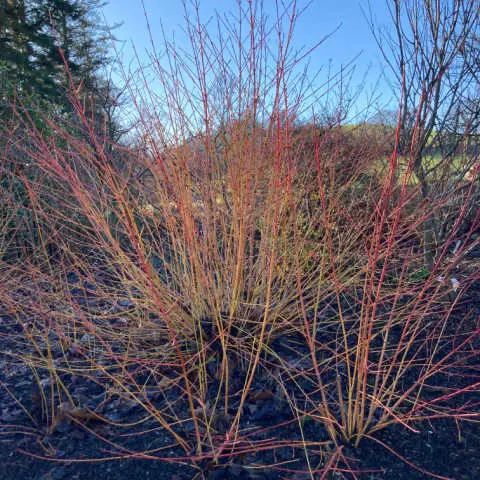
Well-known for its bright and colour stems. Height and spread 2m. It has insignificant white flowers during the summer. I am growing it beneath white stemmed silver birch. The plants are still too young to put on much of a display, but it won’t take long before they are complimenting each other well. As with so much in gardening, patience is key.
Cornus Alba ‘ Kesselringii’ with Cornus stolonifera ‘Flaviramea’
Two more worthy Cornus to grow for the colourful stems during winter. Cornus stolonifera ‘Flaviramea’ provides a good display of yellow stems which stand out nicely on dull days and against a dark background. Cornus Alba ‘Kesselringii’ has blackish purple stems and contrasts well with light stems and tree trunks.
Salix alba ‘Chermesina’ hort.
The red-stemmed variety of white willow is a vigorous medium-size tree that has bright red young stems during the winter. Although the tree can grow to over 12m height and 8m spread, pollarding or coppicing will reduce and maintain the size and allow the brightest young stems to be clearly visible. Grow in full sun or partial shade, it will tolerate most soils, except chalk. Hardy across the UK.
Corylus avellana ‘Contorta’
Corkscrew hazel provides plenty of year-round interest and is hardy across the UK. During winter the contorted, twisting stems provide a good silhouette, and during late winter, yellow, male catkins appear that dangle from the branches and sway in the wind. This large shrub grows to 4-6m height and 2.5-4m spread. It can be pruned hard where space is of a premium. Prefers full sun or partial shade and will grow well in all, but heavy clay soils.
Phormium ‘Evening Glow’
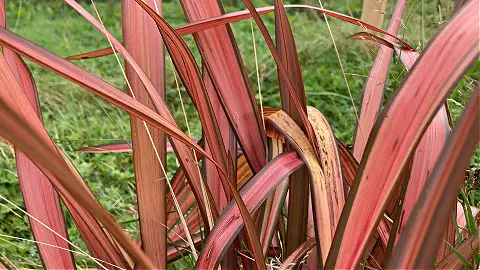
There are several phormium varieties that will provide a splash of colour during the cooler months. I particularly like ‘Evening Glow’ for the pinky-red leaves that are edged with coppery-green. It is evergreen, although the wind on our site batters the leaves throughout winter and remove the worst affected in the spring after vigorous new growth appears. A clump-forming plant that grows to 1m height and spread and looks superb in pots. Phormium ‘Evening Glow’ can be propagated by division in spring.
Prunus serrula
Tibetan cherry is small tree that eventually grows to about 8-12m in height and the round head grows to 8m spread. It does not grow rapidly, taking 20-50 years to reach its full size. Plant this one for the rich, copper colour young bark that is shiny and looks superb in winter sunshine. Grow in full sun to get the best results. Prunus serrula grows in most soil types and situations, but prefers well-draining soil. Team with pale stemmed plants to really highlight the colour of the bark.
Salix matsudana ‘Tortuosa’
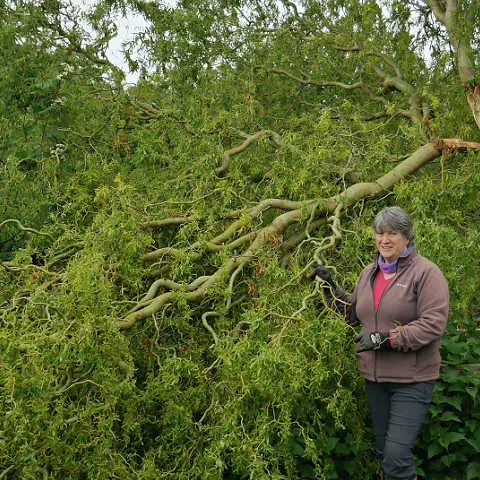
Corkscrew willow grows rapidly to form a medium-sized tree of 7-12m height. We’ve found that the wind will bring down branches, thus reducing the size of the tree, a bit like natural pruning. Once the leaves have fallen in autumn, the joy of this plant can really be seen. The twisty, corkscrew stems add curiosity and interest to the garden landscape throughout the winter months. The youngest twigs and stems have a yellow-green colouring, becoming greener as they mature.
Eucalyptus gunnii
The Cider Gum is a large, vigorous evergreen tree that can grow to more than 12m height and 8m spread. However, if you don’t have space for a large tree, it responds well to hard pruning for a continued supply of young growth. The young leaves are round and silvery-blue and much loved for flower arranging. The cream and brown bark peels revealing a multitude of colours from greys to greens. Eucalyptus gunnii is generally unfussy and will even tolerate a poorly-drained soil. However, it requires full sun and in a sheltered spot. It is hardy throughout most of the UK, except in the harshest of winters.
Apple tree
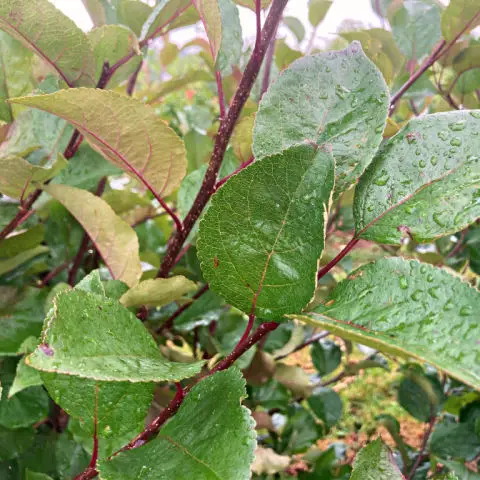
Tickled Pink apple trees have dark red, maroon bark on the younger stems with the bonus of red flowers in spring and dual-purpose fruits that have pink flesh.
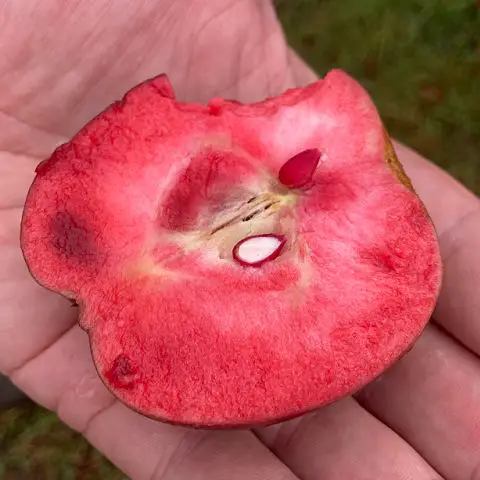
The taste is tangy and sharp, making it ideal for juicing, cooking or eating straight from the tree.
Rainbow chard
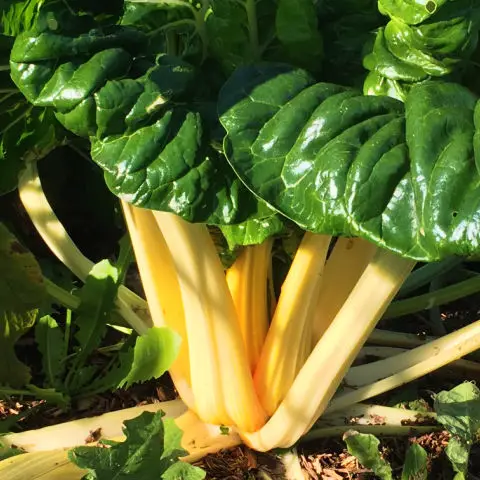
Grow rainbow chard for a range of colours, not in the veg garden, but in your ornamental garden! For the price of one packet of seeds, you can have masses of brightly coloured stems that stay vivid throughout the winter. Pick the leaves if you like chard, but otherwise, simply grow for their great visual impact.
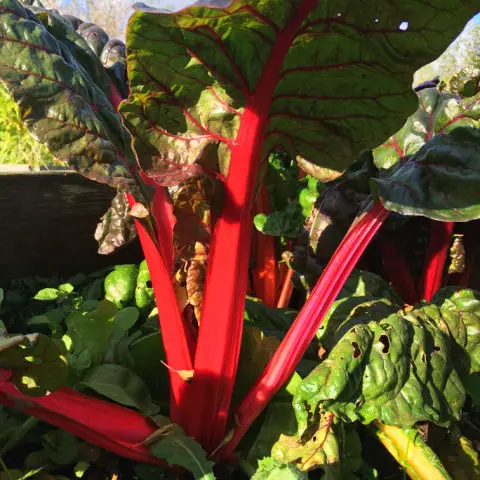
Once they start to go to seed, the plants produce tall, twisting stems. If you have the space, they are an interesting addition to the spring garden.
More information
The article, Bright stems for winter colour, was written originally for Amateur Gardening magazine in autumn 2024. I have updated some of the specific varieties and images, I have added further plants to the list and I’ve included to help you find the suggested plants. For another themed idea for flowers in your garden, try flowers for fragrance in spring.
- Baby pepper inside pepper | Strange vegetable - September 16, 2025
- Biennials to sow in June and July - September 12, 2025
- Protected: Urban back garden - August 28, 2025

Beautiful, Liz ! Thank you !